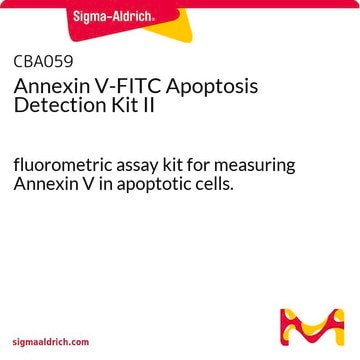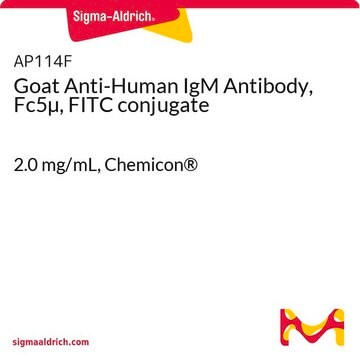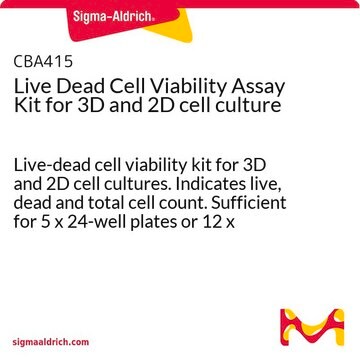It is not possible to have cells that are PI positive without the cells also being positive for Annexin V binding. Cells are PI positive because the membrane has been compromised. If this is the case, Annexin V can also enter the cell and bind to the PS on the internal cell membrane. The gating on the histogram for the FITC channel should be changed so that all cells that are PI positive are also Annexin V positive.
APOAF
Annexin V-FITC Apoptosis Detection Kit
Synonym(s):
Annexin V-FITC, Apoptosis probe FITC
About This Item
Recommended Products
usage
(20 tests)
Quality Level
packaging
pkg of 1 kit
technique(s)
flow cytometry: suitable
application(s)
cell analysis
detection
detection method
fluorometric
shipped in
wet ice
storage temp.
2-8°C
General description
Application
- in staining of LNCaP prostate cancer cells for measuring the G. lucidum extracts activity during the treatment of prostate cancer.[1]
- for tumor cell labelling to study the inhibitory activity of DBP-maf (Vitamin D binding protein-macrophage activating factor) on prostate tumor cells.[2]
- for indirect measurement of flippase activity.[3]
Features and Benefits
- Rapid labeling of cells. Cell staining takes only 10 minutes.
- No cell fixation or processing required, reducing the detection time and allowing the cells to be used for further study.
- Propidium iodide secondary dye is included with the kit to differentiate apoptotic cells from viable and necrotic cells.
Other Notes
Kit Components Only
- APOAFA
related product
Storage Class Code
10 - Combustible liquids
Choose from one of the most recent versions:
Certificates of Analysis (COA)
Don't see the Right Version?
If you require a particular version, you can look up a specific certificate by the Lot or Batch number.
Already Own This Product?
Find documentation for the products that you have recently purchased in the Document Library.
Customers Also Viewed
Articles
Quality control guidelines to maintain high quality authenticated and contamination-free cell cultures. Free ECACC handbook download.
Quality control guidelines to maintain high quality authenticated and contamination-free cell cultures. Free ECACC handbook download.
Quality control guidelines to maintain high quality authenticated and contamination-free cell cultures. Free ECACC handbook download.
Quality control guidelines to maintain high quality authenticated and contamination-free cell cultures. Free ECACC handbook download.
-
When using Product APOAF, Annexin V-FITC Apoptosis Detection Kit, I have cells that are Annexin V FITC negative and PI positive. What are these cells?
1 answer-
Helpful?
-
-
What wavelength do I use to detect Annexin V-FITC and Propidium Iodide when using Annexin V-FITC Apoptosis Detection Kit, Product APOAF?
1 answer-
Annexin V FITC will have a maximum emission of 528 nm. This can be measured in the standard FITC Channel on a flow cytometer (FL1). Propidium Iodide has a maximum emission of 620 nm. This is measured on the short red channel on a flow cytometer (FL2 or FL3).
Helpful?
-
-
When using the Annexin V-FITC Apoptosis Detection Kit, Product APOAF, can I use any buffer for resuspending my cells?
1 answer-
The binding buffer included in the kit needs to be used for resuspending cells. The buffer contains calcium chloride at a final (1X) concentration of 2.5 mM which is necessary for the binding of annexin V to phosphatidylserine.
Helpful?
-
-
Can Product APOAF, Annexin V-FITC Apoptosis Detection Kit be used on fixed cells?
1 answer-
No. Product APOAF, Annexin V-FITC Apoptosis Detection Kit must be performed on live cells in order to measure Apoptosis. The assay is based on the externization of phosphatidylserine from the inner cell membrane to the outer cell membrane. If the membrane is preturbed due to fixation, non-speciifc staining of the inner cell membrane might occur
Helpful?
-
-
Can I use Product APOAF, Annexin V-FITC Apoptosis Detection Kit, to differentiate cells that are dead due to necrosis or apoptosis?
1 answer-
When using a kinetic study (various time points), you can show the progression of the cells from viable (annexin V FITC negative, PI negative), to annexin FITC positive, PI negative (membrane flip) to annexin V FITC positive, PI positive (dead). If there are cells that are double positive when starting, it is not possible to guarantee that the cell death occurred due to apoptosis with this assay.
Helpful?
-
-
What is the Department of Transportation shipping information for this product?
1 answer-
Transportation information can be found in Section 14 of the product's (M)SDS.To access the shipping information for this material, use the link on the product detail page for the product.
Helpful?
-
Active Filters
Our team of scientists has experience in all areas of research including Life Science, Material Science, Chemical Synthesis, Chromatography, Analytical and many others.
Contact Technical Service









